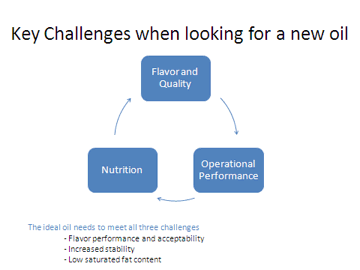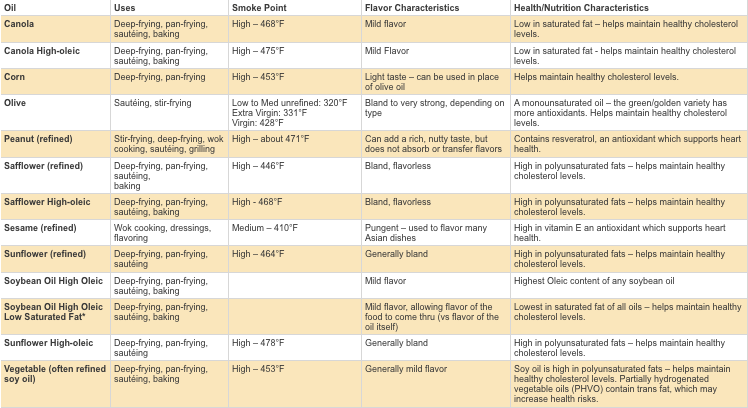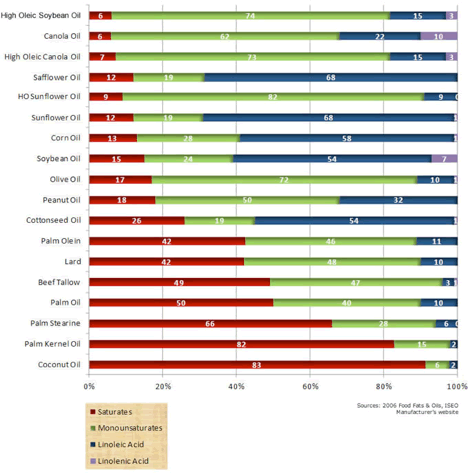Popular Tags
Ask Dr. Potato
With 938 posts, chances are there's already an answer to your question. Please try searching below before submitting a question to Dr. Potato. Use multiple words to help narrow down the results. For example, search for "potatoes" and "group" if looking for an answer on cooking potatoes for large groups.
Five Steps To Better Frying
Are there any basic tips that will help me and my employees do a better job with fried foods?
I always rely on the experts when it comes to frying tips, so check out what www.frymaster.com has to say on the subject with the Five Steps to Better Frying:
During frying, exposure to heat, food, water and air changes the oil forming breakdown products that when accumulated cause the oil to reach the end of its useful life. The Five Factors for Fit Frying are the best practices for frying, which help minimize operating cost, by extending the life of both oil and equipment while ensuring consistent production of great-tasting food.
The Five Factors include:
- Finding the right fryer.
The fried items you offer on your menu determine if an open-pot, tube-type or flat bottom fryer will perform best.
The first step in The Five Factors for FitFrying program is to find the right fryer for the foods you serve. This not only helps produce higher-quality and more healthful foods, but also extends oil life. To find the perfect fryer for your operation, evaluate your menu to determine which fryer is best suited for your needs.
The right fryer is the one that is designed to cook the foods you offer on your menu. In the broadest sense there are two categories of fryers—those with sediment zones and those without. Sediment zones optimize the fry cycle by allowing particles from the food to precipitate away from the cooking area into a location at the bottom of the fryer called “the cold zone.” Different types of fryers offer different “cold zone” collection options.
Fryer-Open-pot fryers have the heat transfer system outside the frypot and deep internal sediment collection zones. They perform well in many frying applications, but are ideal for light to medium sediment foods such as French fries and freezer to fryer foods. They can also handle heavier sediment foods with regular filtration. This type of fryer allows every inch of the frypot to be easily accessed and safely cleaned. Open-pot fryers are available in both gas and electric models.Fryer-Tube-type fryers have the heat exchange system inside the frypot and wide sediment collections zones below the heat exchange tubes, making them the best choice for foods that are fresh battered or heavily breaded such as homemade onion rings or dry dredge fish.
Tube-type fryers are available in large capacity models making them the perfect choice for foods that require a large surface area or operations that have high capacity production needs. Tube–type fryers are only available in gas models.
Fryer-Flat-bottom fryers have large frying areas and no sediment collection zones making this type of fryer best suited for food items that float on top of the oil during the fry cycle. Good applications for this fryer are tempura and wet battered fish. - Selecting the right oil.
Frying oils have different cooking, taste and health features. These qualities impact fryer performance.
Once you’ve selected the right fryer for your cooking needs, the next step in the Five Factors for FitFrying is to find the right oil. Much attention and study has been given to oil in recent years—its composition, how it impacts the frying process, which type(s) work best with certain foods and ways to extend its life cycle.
The qualities of your frying oil impact both oil functionality and food quality. Base oils for deep-frying include soy, canola, corn, grape seed, peanut, safflower, sunflower, blends and more. Each type of oil has unique characteristics such as flavor, smoke point, nutritional profile and stability.
Prime considerations for foodservice oils used in deep fat frying, pan frying and griddle frying include sensory attributes, fry life, cost, availability and nutritional considerations. Consider the features and benefits of the different base oils as they relate to your cooking application to select the best oil for your restaurant application.

Historically, frying oil stability was achieved primarily through partial hydrogenation, an artificial process in which hydrogen is applied to the processing of frying oil. This process often creates artificial trans-fat and/or increased saturated fat which are commonly associated with increased health risks, such as heart disease.
Given recent food labeling, nutritional and menu legislation movements and policy changes, the food industry is seeking vegetable oils that not only have enhanced functionality but minimize levels of trans- and saturated fat.
In light of these changes, a new generation of oils has been introduced in the marketplace. Advanced plant breeding technologies have helped create oils that provide enhanced stability and functionality for deep frying, while meeting healthy oil requirements and often improving the mono- and polyunsaturated fatty acid (“good” fats) content and removing partial hydrogenation from the label.
In addition, these enhanced oils also provide your operation with greater stability and functionality needed for deep frying. Greater stability and functionality allow you to have a longer fry life and more versatile oil, creating savings in your restaurant’s bottom line.
Examples of new generation oils include high-oleic, mid-oleic and low-linolenic varieties. Oil manufacturers also offer blends, providing a wider variety of unique flavor profiles and performance.

From a saturated fat content, the following chart illustrates how the various oils stack up:
- Selecting the right food.
The fats in foods and oil exchange during cooking so considering the type of fat in the foods purchased for frying is important especially when frying trans-fat-free.
Frying foods from a fresh state
When frying fresh foods (i.e., foods that have not been pre-breaded or pre-fried), naturally-occurring fats in those fresh foods can affect frying. Most foods to be fried have some naturally-occurring fat. In addition, the breading in which those fresh foods are to be fried may add additional fat.
Wings and so-called "naked" (skinless) wings are examples of how both the food itself, and the oil in which it is cooked, can affect the finished food's fat content. A fried wing without skin or breading will have a lower total fat content than a fried wing with skin. The total fat in either fried wing, with or without skin, would also be increased by oil absorbed during frying.
Fresh-cut fries are another example. Raw potatoes have no natural fat themselves; so, the fat in a fried potato would have the characteristics of coatings and the frying oil rather than the raw food.
Frying pre-prepared frozen foods
Frying pre-prepared frozen foods (i.e., foods that are pre-breaded or pre-fried) introduces several variables into the frying process that affect the finished food's fat content, including:
• The type of oil used in food preparation: For example, if a food was par-fried with partially hydrogenated oil then frozen, the par-frying oil will leach into your frying oil during the finish frying. Even if you are using trans-fat-free frying oil, the finished food product will contain trans fats because of the par-frying oil, potentially at levels above the standard of 0.5 mg per serving that qualifies as trans-fat-free.
• Naturally-occurring fats in frozen food: Similar to foods fried from a fresh state, the fats that naturally occur in foods that have been frozen can have an impact on frying. Naturally-occurring fats will also migrate from the food to the fryer oil during the finish frying process.
Best practices
To minimize the effect of undesired fat transfer during frying, consider these best practices:
• Don't mix oils by frying a multitude of items in one fryer. The ideal situation is to dedicate one fryer to proteins, coated or battered products, and another strictly for uncoated items such as fries. Fryers are often purchased as multiple units within a battery, and many fryers have split frypots that allow separating frying oil for just this application.
• Choose trans-fat-free foods. Fortunately, numerous trans-fat-free foods are now available, in addition to the many trans-fat-free oils that are currently on the market with more on the way.
Selecting trans-fat-free food for frying, frying in healthful oil, and following frying best practices will ensure you are consistently providing your customers with high-quality fried foods that are both flavorful and healthy. - Using best practices or the “right” cooking process.
Keeping contaminants out of the oil and cooking at recommended temperatures and times all contribute to maximal oil life.
The composition of oil changes as it interacts physically and chemically with food, oxygen, and heat. By-products are created as a result of this process, some of which evaporate and some of which stick around, changing the oil's characteristics.
Contaminants, including food particles, water, and starches migrating from food during cooking also contribute to the breakdown of oil quality.There are several ways operators can minimize the by-products produced during frying and slow changes to the oil’s quality.
An easy way to be mindful of them is to remember the acronym CWASH.
Avoid unnecessary exposure to Crumbs, Water, Air, Salt, and Heat.
C:After loading fry baskets, shake them away from the frypot area. This allows loose food particles and sediment to fall out of the fry baskets safely away from the oil.
W: Make sure that the frypot and filter pan are completely dried after a boil-out.
A: Cover frypots when not in use.
S: Season fried foods after cooking and away from the fryer.
H: Avoid high heat (over 350° F) frying . Doing so extends oil life and avoids situations in which foods are cooked too quickly at a temperature that is too high.
Careful and frequent filtering will remove the solid particles that normally collect in the oil during frying such as food particles and non-dissolved salts. If oil is contaminated by any unexpected substance or object it should be disposed of immediately in accordance with safe handling guidelines. The fryer should also be carefully cleaned and sanitized before being used again.
Follow the manufacturer’s recommendations and instructions for frypot cleaning, and replace oil promptly when needed.
For best frying results, oil temperatures should be maintained at 340°F–350°F at the beginning of the fry cycle, reduced for a short period after the food is dropped in the oil, then elevated again to 340°F-350°F. This process is known as a cooking curve that optimizes fried food quality.
Note: In Europe, some EU countries have adopted standards for measuring oil breakdown and require that frying oil be changed based on the results of those measurements. - Providing the right maintenance.
Oil Maintenance:
• Filter frying oil twice daily to remove crumbs.
• Routine and thorough cleaning of the frypot is a must to extend oil life. A deep clean of the frypot (boil out) prior to adding fresh oil will ensure that oil-degrading residues are removed from the frypot.
Follow the ABCs of Fryer Preventive Maintenance to conduct daily filtration and routine boil outs of the frypot. Follow fryer equipment manufacturer’s literature for additional filtration and cleaning instructions.
Fryer Equipment Maintenance:
• Read the accompanying literature from the fryer manufacturer and follow the recommended guidelines for operation and maintenance to ensure reliable and long lasting performance.
• When fryer maintenance is needed, use authorized, factory-trained technicians, and be sure to use only approved replacement parts in order to achieve maximum fryer life.
Source: Frymaster LLC, www.frymaster.com
Share This

Dr. Potato isn't a real doctor but a team of potato experts ready to answer all your potato questions.
Click here to submit »
Dr. Potato Categories
The Idaho Potato Commission
Established in 1937, the Idaho Potato Commission (IPC) is a state agency that is responsible for promoting and protecting the famous "Grown in Idaho®" seal, a federally registered trademark that assures consumers they are purchasing genuine, top-quality Idaho® potatoes. Idaho's ideal growing conditions, including rich, volcanic soil, climate and irrigation differentiate Idaho® potatoes from potatoes grown in other states.
Contact
661 South Rivershore Lane
Suite 230
EAGLE, ID 83616
Phone: 208-334-2350
Fax: 208-334-2274
More

